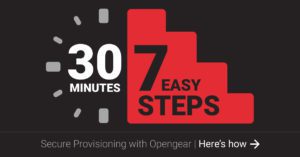Zero Touch Provisioning allows network administrators to automate repetitive tasks, reduce human touchpoints and minimize errors. For enterprises with any significant deployment, ZTP is scalable and allows engineering teams to streamline processes using automation, and leverage staff as effectively as possible.
Traditional deployments are a very manual process. They are time consuming, costly and error prone. We call it the “rinse and repeat” method. An engineer may have to go on site, log into a single unit through the CLI and configure the device for basic operation. All of this has to be done before the process of configuration can be completed from the central management system. It makes you think, there’s got to be an easier way – and there is.
Leveraging ZTP
Zero Touch Provisioning combines automation and provisioning capabilities to do most of the heavy lifting during deployment. This solution simplifies the provisioning and configuration of devices with a process that can be completed in a matter of hours, instead of days. For enterprises who don’t have the IT staff to send on site, or are limited by travel restrictions, ZTP ensures devices can for the most be part be set up remotely, without the need for a highly technical engineer on site. And for those in the healthcare, financial services and retail industries with many new sites to constantly get up and running, this automation can enable faster deployment across wider geographies.
ZTP has many benefits. These include:
- Ensuring compliance and security policies are adhered to
- Reducing costs by eliminating the need for extra hardware and staff
- Minimizing errors from manual configuration
ZTP With Opengear
The basis of Zero Touch Provisioning is automation. ZTP of managed devices using an Opengear appliance involves an integrated DCHP server and the Secure Provisioning Module of Lighthouse. This allows engineers to completely automate the provisioning process on Day One remotely. The device is sent to the remote site without any configurations other than the Lighthouse address. The Opengear is configured to recognize the managed devices and provide them with the appropriate operating system image and configuration files.
 Before being shipped, each Opengear appliance is preconfigured for 4G LTE network connectivity so that once it arrives at the remote site it can securely connect to Lighthouse. The appliance is shipped, racked and stacked. After the appliance has been powered up, the embedded TPM 2.0 chip performs an integrity test to ensure the device hasn’t been tampered with during shipping. The device then creates a WAN bootstrap network to form an independent Out-of-Band network between the remote site and central operations. It receives a provisioning bundle based off of the devices that need to be provisioned. The network admin then remotely prepares the operating system images and configuration files in Lighthouse while the remote tech cables up the managed devices. Opengear’s distribution policy ensures the correct configuration files are delivered to each device.
Before being shipped, each Opengear appliance is preconfigured for 4G LTE network connectivity so that once it arrives at the remote site it can securely connect to Lighthouse. The appliance is shipped, racked and stacked. After the appliance has been powered up, the embedded TPM 2.0 chip performs an integrity test to ensure the device hasn’t been tampered with during shipping. The device then creates a WAN bootstrap network to form an independent Out-of-Band network between the remote site and central operations. It receives a provisioning bundle based off of the devices that need to be provisioned. The network admin then remotely prepares the operating system images and configuration files in Lighthouse while the remote tech cables up the managed devices. Opengear’s distribution policy ensures the correct configuration files are delivered to each device.
For engineering teams dealing with travel restrictions, lack of staff and trying to meet enterprise network demands, Opengear’s smart solutions will provide you with the capabilities to automate most of your processes, all from the comfort of your own home. To learn more about ZTP with Opengear, visit our NetOps Automation Page.
